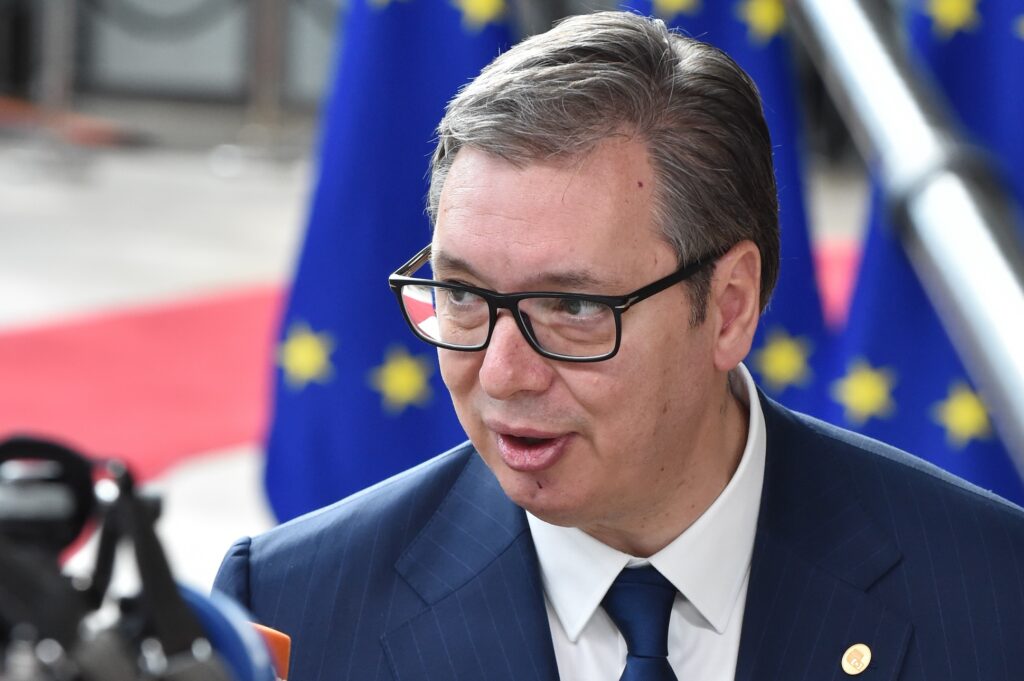A couple of months ago, in an interview with Al Jazeera, Kosovo’s Prime Minister Albin Kurti claimed that the September attack on Kosovo police by Serbian gunmen in northern Kosovo was planned by Serbian President Aleksandar Vučić in an effort “to destabilise” Kosovo in the hopes of starting a war.
Such a statement does not serve the public’s interest well or produce political or strategic gains for him. Not only that, Serbia’s President Aleksandar Vučić has nothing to gain by waging a war against Kosovo; he stands only to be humiliated by NATO, which is committed to Kosovo’s national security.
Whereas Vučić continues to placate Putin, he values Serbia’s relationship with the US and would not undertake such a reckless act.
As he recently stated, “For us, it is of the utmost importance that peace in the region is not disturbed and Serbia will continue to behave responsibly and contribute to stability in the Balkans,” adding that Serbia and the US will work to preserve Serbian-American relations.
Moreover, Vučić knows that ultimately, Serbia’s alliance with the US and the EU, rather than Russia, will best serve Belgrade’s long-term national interests.
A responsible Serbia?
Vučić wants to project power and sensible leadership to strengthen himself domestically while demonstrating to the West that he is a responsible leader who will always endeavour to maintain regional stability.
He stated that “for us, it is of great importance that the peace in the region is not broken and that Serbia will continue to act responsibly and contribute to stability in the Balkans.”
Nevertheless, he promised to continue purchasing arms from China and other countries, including anti-aircraft systems, fighter planes, and drones, and likes to flex his muscles as he has multiple times moved a small contingency of Serbian troops to Kosovo’s border in what is considered by NATO as hostile actions.
One need not take Vučić’s words for granted; a closer look at the Balkans’ overall political and military environment suggests that no country in the region wants to heighten the tension, which may accidentally precipitate a violent conflagration. NATO’s decision in early October to dispatch 200 British soldiers and 130 Romanian soldiers to reinforce its peacekeeping mission in Kosovo is not such a massive power meant to deter Belgrade. Vučić fully understands the high stakes for him if he steps out of line.
The purpose of the NATO forces augmentation in Kosovo, which also includes the purchase of drones and anti-tank missiles, mainly from Turkey, is to keep tensions in the Western Balkans under control, as NATO Secretary General Jens Stoltenberg stated.
In that regard, the US decision to sell 240 portable Javelin missile systems that can destroy tanks and other armored vehicles was designed to send a message to Russia’s President Vladimir Putin that the US is fully engaged and committed to improving the security of its European partners, which is critical for both political and economic stability in Europe.
For the ordinary Kosovar, though, when put together, Kurti’s warning about a potential war with Serbia, the dispatch of more EU forces, and the US sale of Javelin missiles could amount to a looming war with Serbia. In fact, the last thing that Vučić wants is a war against Kosovo that would immediately draw NATO into the fray—a war that he will not only severely lose but would also irreversibly damage Serbia’s prospect of joining the EU. This is something that Vučić wants to avoid at all costs.
Time for Kurti to be prudent
Although Prime Minister Kurti is duty-bound to ensure Kosovo’s national security, he should view it in the context of NATO’s overall commitment to the stability of the Balkans and how other conflicts might impact that.
Even though the turmoil in the Middle East is not likely to spill over into the Balkans, the US is rightfully demonstrating in words and deeds that it takes the security and the development of events in the Balkan region very seriously and will act promptly to prevent any miscalculation by a would-be enemy, especially Russia.
The US’ sale of Javelin missiles to augment Kosovo’s military forces will not be the last shipment of military hardware; other supplies of military equipment will follow it as the Kosovo Security Forces aims to transition into a professional military force by 2028 to meet NATO standards.
For this reason, it will be prudent for Kurti to take what Vučić says or does with some reservation. Vučić is not interested in violently engaging Kosovo as he is extremely keen that his losses will far outweigh any gain. Therefore, Kurti’s suggestion that Serbia is planning for war against Kosovo does nothing but cause unnecessary public tension and stress, destabilise the economy, and create a rush to stock unperishable goods, often precipitating inflation and creating financial distress and social tension.
Unless Kurti’s warning of a potential war against Serbia is purposely designed to strengthen his political standing and rally the public around him in an election year, which I do not believe is the case, he should know by now that Vučić speaks loudly but carries a small stick.
Photo: Aleksandar Vučić at a European Union-Western Balkans summit. © European Union.







